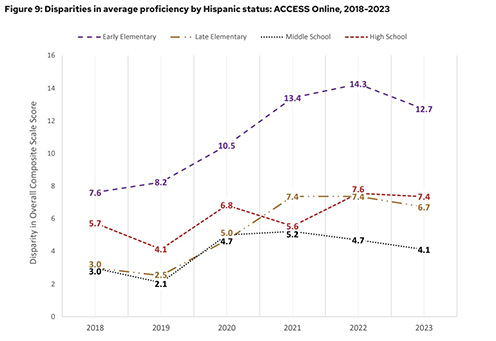English learners’ proficiency scores continue to decline since pandemic, report finds

By Hannah Haynes
Emerging research and reports suggest that K-12 students identified as English learners (ELs) may have been especially vulnerable to COVID-19 pandemic-induced disruptions to their education. A new report from WIDA finds that proficiency scores for ELs have continued to decline since the pandemic.
The latest report, third in the series and authored by WIDA researchers Glenn Poole and Narek Sahakyan, continues to explore trends in English learner proficiency since the start of the pandemic.
WIDA, housed in the Wisconsin Center for Education Research at UW–Madison, provides language development resources to those who support the academic success of multilingual learners. That includes a suite of summative English language proficiency assessments, known as ACCESS for ELLs, that more than 2.5 million students take annually.
Evidence presented in this and previous WIDA reports shows that since the onset of the pandemic in 2020, the average proficiency of ELs in the WIDA Consortium has continued to decline in almost all grade levels and in most language domains. Though student assessment fully resumed in 2022 and more students than ever took ACCESS Online in 2023, the test scores for many students do not indicate a return to pre-pandemic “normalcy.”
The report found that ELs in higher grade levels especially are showing slower growth than pre-pandemic averages.
“If students do not receive the supports they need to reach reclassification-level proficiency, many more are likely to receive the ‘long-term’ label, which—in addition to further stigmatizing students identified as ELs—has implications for school and district accountability,” Sahakyan said.
Delayed language proficiency and reclassification out of EL status may also contribute to additional barriers that many language learners face in accessing advanced coursework and academic milestones important for college and career readiness.
Poole and Sahakyan’s analysis also found that pandemic-related disruptions may have exacerbated some of the existing and sizeable disparities between students identified as Hispanic and non-Hispanic.

The above graph shows composite scale scores for ACCESS Online from 2018-2023 for early elementary, late elementary, middle school and high school Hispanic students. The early elementary student scores show overall increasing scores that are far above the scores for the other three grade clusters, whose scores do not increase as much over the years.
Across the WIDA Consortium, approximately two-thirds of tested ELs are identified as Hispanic.
These findings point to unbalanced opportunities for these students — even after schools returned to in-person instruction.
“More nuanced analyses are needed to unpack and understand how different subgroups of students may have faced disproportionate challenges during the pandemic and how those challenges may continue to affect students,” Poole said.
The latest administration of ACCESS recently wrapped up across the Consortium. WIDA research reports will continue to inform the national conversation around post-pandemic recovery and English learner outcomes in K-12 education. Future WIDA research will also examine disparities in outcomes between other EL subgroups.
In the meantime, Sahakyan and Poole suggest that states and districts conduct their own analyses and determine what resources and supports are appropriate to meet the unique needs of their students.





